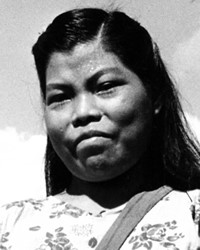The Kakataibo resisted contact with outsiders since initial attempts by Franciscan missionaries to reach them in the 1700s. That changed in the 1930s-1940s, when a Kakataibo youth who had been captured and raised by a nearby tribe conquered many of the Kakataibos, brought them into contact with the outside world, and opened the way for the construction of a road through their land. This brought the Kakataibo into contact with epidemics that decimated at least half of their population. However, some Kakataibo groups never came into contact with civilization and remain in voluntary isolation.
The Summer Institute of Linguistics (SIL) began working with the Kakataibo in 1946 and have since completed translating the New Testament. Since then, foreign mission agencies and a variety of Peruvian and indigenous missionaries have worked among the Kakataibo, concentrating on church planting and leadership development.
Today, there are seven churches among the Kakataibo, each at various levels of spiritual maturity. In general, church leaders tend to be more devoted to following Christ, while few church members actively apply God's Word to their daily lives. Many are tempted to mix Christian practices with traditional shamanistic rituals.
The Kakataibo live in the central Peruvian Amazon jungle along the Alejandro, Aguaytia, and Sungaro Rivers and their confluents.
The Kakataibo live an agrarian subsistence lifestyle based on farming, hunting, and fishing. Principal crops include plantains, manioc, and maize. They have learned to raise livestock such as cows for commercial profit, and they sell goods such as plantains, meat, artisan handcrafts, and medicinal plants.
Traditionally, the Kakataibo lived as extended family units in one large house surrounded by smaller structures used for making pottery, keeping chickens, and storing goods. Today, they live in small village settlements as individual family units. Women formerly wore skirts woven from fiber, while men wore cotton armbands decorated with various seeds, nuts, teeth, and shells for special occasions. Today, simple garments from Western culture predominate.
Roughly one-third of the population, particularly older people and women, are illiterate. Children are first taught in Kakataibo in elementary school, but secondary school levels function in Spanish. The Kakataibo are known for producing beautiful pottery with red and black designs along with mats, baskets, and cotton nets.
The Kakataibo traditionally believed that a sun god created man and taught him what is correct. While foreigners lost touch with those divine beliefs, the Kakataibo remained the only people who passed along their ancestors' teachings and knew the right way to live. They believe that each person has a soul whose purpose is to protect, teach, help, and give good dreams to its owner. After death, the soul separates from its owner and becomes an ancestor.
The Kakataibo hold to animistic views that seek to discover spiritual causes for life problems and resolve them through shamanistic rituals. The head of each household is responsible for using both physical and spiritual means, such as animistic rituals and chanting, to protect his family. The Kakataibo use a variety of songs to accomplish their purposes, such as attracting a woman, drawing in wild game, or warding off snakes.
Because they believe that the spirits of plants and animals have great power, the Kakataibo have many food taboos, like what kinds of food and animals that new parents must avoid consuming or touching to avoid bringing harm to infants.
There is a general lack of sexual integrity in the Kakataibo villages, and younger generations have lost previous cultural values regarding marriage. Homosexuality and marital infidelity have greatly increased, and an AIDS epidemic is now spreading.
Believers still lack spiritual maturity even though they have been Christians for many years. The church as a whole has a low commitment to live out the gospel in their daily lives and grow in their faith in Christ.
The church focuses entirely on the adults and does not work intentionally with children or youth, so there is also a great need for a holistic work among the youth in areas such as discipleship, social relations, sexuality, and education.
Pray for spiritual growth among believers, maturity in church leadership, and a commitment among believers to live out the gospel and fulfill the mission as a church.
Pray that God would raise up leaders and teachers with a conviction and commitment to disciple the children and youths.
Scripture Prayers for the Kakataibo in Peru.
| Profile Source: Pioneers |











